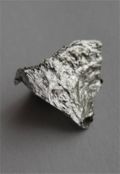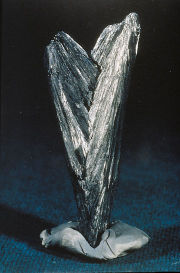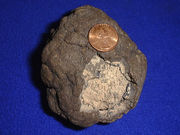Manganese
2007 Schools Wikipedia Selection. Related subjects: Chemical elements
|
||||||||||||||||||||||||||||||||||||||||
| General | ||||||||||||||||||||||||||||||||||||||||
|---|---|---|---|---|---|---|---|---|---|---|---|---|---|---|---|---|---|---|---|---|---|---|---|---|---|---|---|---|---|---|---|---|---|---|---|---|---|---|---|---|
| Name, Symbol, Number | manganese, Mn, 25 | |||||||||||||||||||||||||||||||||||||||
| Chemical series | transition metals | |||||||||||||||||||||||||||||||||||||||
| Group, Period, Block | 7, 4, d | |||||||||||||||||||||||||||||||||||||||
| Appearance | silvery metallic |
|||||||||||||||||||||||||||||||||||||||
| Atomic mass | 54.938045 (5) g/mol | |||||||||||||||||||||||||||||||||||||||
| Electron configuration | [Ar] 3d5 4s2 | |||||||||||||||||||||||||||||||||||||||
| Electrons per shell | 2, 8, 13, 2 | |||||||||||||||||||||||||||||||||||||||
| Physical properties | ||||||||||||||||||||||||||||||||||||||||
| Phase | solid | |||||||||||||||||||||||||||||||||||||||
| Density (near r.t.) | 7.21 g·cm−3 | |||||||||||||||||||||||||||||||||||||||
| Liquid density at m.p. | 5.95 g·cm−3 | |||||||||||||||||||||||||||||||||||||||
| Melting point | 1519 K (1246 ° C, 2275 ° F) |
|||||||||||||||||||||||||||||||||||||||
| Boiling point | 2334 K (2061 ° C, 3742 ° F) |
|||||||||||||||||||||||||||||||||||||||
| Heat of fusion | 12.91 kJ·mol−1 | |||||||||||||||||||||||||||||||||||||||
| Heat of vaporization | 221 kJ·mol−1 | |||||||||||||||||||||||||||||||||||||||
| Heat capacity | (25 °C) 26.32 J·mol−1·K−1 | |||||||||||||||||||||||||||||||||||||||
|
||||||||||||||||||||||||||||||||||||||||
| Atomic properties | ||||||||||||||||||||||||||||||||||||||||
| Crystal structure | cubic body centered | |||||||||||||||||||||||||||||||||||||||
| Oxidation states | 7, 6, 4, 2, 3 (strongly acidic oxide) |
|||||||||||||||||||||||||||||||||||||||
| Electronegativity | 1.55 (Pauling scale) | |||||||||||||||||||||||||||||||||||||||
| Ionization energies ( more) |
1st: 717.3 kJ·mol−1 | |||||||||||||||||||||||||||||||||||||||
| 2nd: 1509.0 kJ·mol−1 | ||||||||||||||||||||||||||||||||||||||||
| 3rd: 3248 kJ·mol−1 | ||||||||||||||||||||||||||||||||||||||||
| Atomic radius | 140 pm | |||||||||||||||||||||||||||||||||||||||
| Atomic radius (calc.) | 161 pm | |||||||||||||||||||||||||||||||||||||||
| Covalent radius | 139 pm | |||||||||||||||||||||||||||||||||||||||
| Miscellaneous | ||||||||||||||||||||||||||||||||||||||||
| Magnetic ordering | nonmagnetic | |||||||||||||||||||||||||||||||||||||||
| Electrical resistivity | (20 °C) 1.44 µΩ·m | |||||||||||||||||||||||||||||||||||||||
| Thermal conductivity | (300 K) 7.81 W·m−1·K−1 | |||||||||||||||||||||||||||||||||||||||
| Thermal expansion | (25 °C) 21.7 µm·m−1·K−1 | |||||||||||||||||||||||||||||||||||||||
| Speed of sound (thin rod) | (20 °C) 5150 m/s | |||||||||||||||||||||||||||||||||||||||
| Young's modulus | 198 GPa | |||||||||||||||||||||||||||||||||||||||
| Bulk modulus | 120 GPa | |||||||||||||||||||||||||||||||||||||||
| Mohs hardness | 6.0 | |||||||||||||||||||||||||||||||||||||||
| Brinell hardness | 196 MPa | |||||||||||||||||||||||||||||||||||||||
| CAS registry number | 7439-96-5 | |||||||||||||||||||||||||||||||||||||||
| Selected isotopes | ||||||||||||||||||||||||||||||||||||||||
|
||||||||||||||||||||||||||||||||||||||||
| References | ||||||||||||||||||||||||||||||||||||||||
Manganese ( IPA: /ˈmaŋgəniːz/, /ˈmæŋgəniːz/) is a chemical element in the periodic table that has the symbol Mn and atomic number 25.
Notable characteristics
Manganese is a gray-white metal, resembling iron. It is a hard metal and is very brittle, fusible with difficulty, but easily oxidized. Manganese metal is ferromagnetic only after special treatment.
The most common oxidation states of manganese are +2, +3, +4, +6 and +7, though oxidation states from +1 to +7 are observed. Mn2+ often competes with Mg2+ in biological systems, and manganese compounds where manganese is in oxidation state +7 are powerful oxidizing agents.
Applications
Manganese is essential to iron and steel production by virtue of its sulfur-fixing, deoxidizing, and alloying properties. Steelmaking, including its ironmaking component, has accounted for most manganese demand, presently in the range of 85% to 90% of the total demand. Among a variety of other uses, manganese is a key component of low-cost stainless steel formulations and certain widely used aluminium alloys. It is also added to gasoline in order to reduce engine knocking. Manganese(IV) oxide (manganese dioxide) is used in the original type of dry cell battery. Manganese dioxide is also used as a reagent in organic chemistry for the oxidation of benzylic alcohols (i.e. adjacent to an aromatic ring). Manganese is used to decolorize glass (removing the greenish tinge that presence of iron produces) and, in higher concentration, make violet-colored glass. Manganese oxide is a brown pigment that can be used to make paint and is a component of natural umber. Potassium permanganate is a potent oxidizer and used in chemistry and in medicine as a disinfectant. Manganese phosphating is used for rust and corrosion preventation on steel. It is very occasionally used in coins; the only United States coins to use manganese were the "Wartime" nickel from 1942–1945, and the Sacagawea Dollar (2000–present).
The overall level and nature of manganese use in the United States is expected to remain about the same in the near term. No practical technologies exist for replacing manganese with other materials or for using domestic deposits or other accumulations to reduce the complete dependence of the United States on other countries for manganese ore.
Substitutes: Manganese has no satisfactory substitute in its major applications. In minor applications, (e.g., manganese phosphating), zinc and sometimes vanadium are viable substitutes.
History
Manganese (apparently from Latin magnes, meaning "magnet") was in use in prehistoric times; paints that were pigmented with manganese dioxide can be traced back 17,000 years. The Egyptians and Romans used manganese compounds in glass-making, to either remove color from glass or add colour to it. Manganese can be found in the iron ores used by the Spartans. Some speculate that the exceptional hardness of Spartan steels derives from the inadvertent production of an iron-manganese alloy.
In the 17th century, German chemist Johann Glauber first produced permanganate, a useful laboratory reagent (although some people believe that it was discovered by Ignites Kaim in 1770). By the mid 18th century, manganese dioxide was in use in the manufacture of chlorine. The Swedish chemist Scheele was the first to recognize that manganese was an element, and his colleague, Johan Gottlieb Gahn, isolated the pure element in 1774 by reduction of the dioxide with carbon. Around the beginning of the 19th century, scientists began exploring the use of manganese in steelmaking, with patents being granted for its use at the time. In 1816, it was noted that adding manganese to iron made it harder, without making it any more brittle. In 1837, British academic James Couper noted an association between heavy exposure to manganese in mines with a form of Parkinson's Disease. In 1912, manganese phosphating electrochemical conversion coatings for protecting firearms against rust and corrosion were patented in the United States, and have seen widespread use ever since.
Biological role
Manganese is an essential trace nutrient in all forms of life.
The classes of enzymes that have manganese cofactors are very broad and include such classes as oxidoreductases, transferases, hydrolases, lyases, isomerases, ligases, lectins, and integrins. The best known manganese-containing polypeptides may be arginase, Mn-containing superoxide dismutase, and the diphtheria toxin.
Occurrence
Manganese occurs principally as pyrolusite ( MnO2), and to a lesser extent as rhodochrosite ( MnCO3). Land-based resources are large but irregularly distributed; those of the United States are very low grade and have potentially high extraction costs. Over 80% of the known world manganese resources are found in South Africa and Ukraine. Other important manganese deposits are in China, Australia, Brazil, Gabon, India, and Mexico.
US Import Sources (1998-2001): Manganese ore: Gabon, 70%; South Africa, 10%; Australia, 9%; Mexico, 5%; and other, 6%. Ferromanganese: South Africa, 47%; France, 22%; Mexico, 8%; Australia, 8%; and other, 15%. Manganese contained in all manganese imports: South Africa, 31%; Gabon, 21%; Australia, 13%; Mexico, 8%; and other, 27%.
Manganese is mined in Burkina Faso and Gabon.
Vast quantities of manganese exist in manganese nodules on the ocean floor. Attempts to find economically viable methods of harvesting manganese nodules were abandoned in the 1970s.
Compounds
Potassium permanganate, also called Condy's crystals, is a commonly used laboratory reagent because of its oxidizing properties and finds use as a topical medicine (for example, in the treatment of fish diseases).
Manganese(IV) oxide (manganese dioxide) is used in dry cells, and can be used to decolorize glass that is polluted by trace amounts of iron. Manganese compounds can color glass an amethyst color, and are responsible for the colour of true amethyst. Manganese dioxide is also used in the manufacture of oxygen and chlorine, and in drying black paints.
The most stable oxidation state for manganese is +2, and many manganese(II) compounds are known, such as manganese(II) sulfate (MnSO4) and manganese(II) chloride (MnCl2). This oxidation state is also seen in the mineral rhodochrosite, ( manganese(II) carbonate). The +3 oxidation state is also known, in compounds such as manganese(III) acetate, but these are quite powerful oxidizing agents.
Methylcyclopentadienyl manganese tricarbonyl is used as an additive in unleaded gasoline.
Isotopes
Naturally occurring manganese is composed of 1 stable isotope; 55Mn. 18 radioisotopes have been characterized with the most stable being 53Mn with a half-life of 3.7 million years, 54Mn with a half-life of 312.3 days, and 52Mn with a half-life of 5.591 days. All of the remaining radioactive isotopes have half lives that are less than 3 hours and the majority of these have half lives that are less than 1 minute. This element also has 3 meta states.
Manganese is part of the iron group of elements which are thought to be synthesized in large stars shortly before supernova explosion. 53Mn decays to 53Cr with a half-life of 3.7 million years. Because of its relatively short half-life, 53Mn is an extinct radionuclide. Manganese isotopic contents are typically combined with chromium isotopic contents and have found application in isotope geology and radiometric dating. Mn-Cr isotopic ratios reinforce the evidence from 26Al and 107Pd for the early history of the solar system. Variations in 53Cr/52Cr and Mn/Cr ratios from several meteorites indicate an initial 53Mn/55Mn ratio that suggests Mn-Cr isotopic systematics must result from in-situ decay of 53Mn in differentiated planetary bodies. Hence 53Mn provides additional evidence for nucleosynthetic processes immediately before coalescence of the solar system.
The isotopes of manganese range in atomic weight from 46 amu (46Mn) to 65 amu (65Mn). The primary decay mode before the most abundant stable isotope, 55Mn, is electron capture and the primary mode after is beta decay.
Precautions
Manganese compounds are less toxic than those of other widespread metals such as iron, nickel and copper compounds. However manganese is toxic in excess. Exposure to manganese dusts and fumes should not exceed the ceiling value of 5 mg/m3 for even short periods because of its toxicity level.
Acidic permanganate solutions will oxidize any organic material they come into contact with. The oxidation process can generate enough heat to ignite some organic substances.
In 2005, a study suggested a possible link between manganese inhalation and central nervous system toxicity in rats. It is hypothesized that long-term exposure to the naturally-occurring manganese in shower water puts up to 8.7 million Americans at risk.
A form of Parkinson's Disease-type neurodegeneration called " Manganism" has been linked to manganese exposure amongst miners and smelters since the early 19th Century. Allegations of inhalation-induced manganism have been made regarding the welding industry. Manganese exposure is regulated by OSHA.



